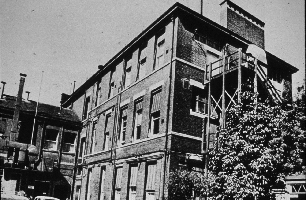 |
| Sir Frank Macfarlane Burnet |
 |
| The First known picture of Frank Macfarlane Burnet |
| Frank Macfarlane Burnet was born in Tralagon, a small country town in the state of Victoria, on the 3rd September 1899. Both his parents were from Scotland, his father was a country branch manager of the Colonial Bank. He came to Australia in 1880. Mac, as Frank was called in his childhood, was the second of seven children in his family. In 1909 his family moved to Terang, and in 1912 Mac won a schoolarship to attend Gellong College as a border. During his schooling years it became quite clear what |
| Mac was interested in, nature.He had a passion for collecting beetles and he would roam the back paddock of his house for animals and insects. Mac also did very well at school, he graduated in 1916 and was the dux of the school. Frank had always been shy as he described in his autobiography: "I have always been something of a socal misfit, and uneasy with strangers." In 1917 Mac won another schoolarship, this time to Ormand College in Melbourne where he took a medical course. On the 6th of January, 1921, his diary records say that his life goal was to become a member of the medical research institute and make a good therien. In 1922 Frank completed his medical course, coming second in his year. Frank Burnet became a pathology registar at the Walter and Eliza Hall Institute in 1923, beginning a 42 year association with them. |
 |
| Walter and Eliza Hall Institute |
| In 1923 Burnet was doing a usual checkup on the urine of a patient with a kidney infection, when he noticed two large clear arears on the top of the bacterial growth. He rembered what a lecturer from his University had called these areas. Bacteriophages, (eaters of bacteria), he had also said knowone really knew anything about them. Burnet set out to discover what it was and a few days later he concluded, "it was a virulent organism that must have been multiplied in the host bacterial cell, finally killing it realising 50 progeny |
| in a single burst." This was Burnet's first scientific breakthrough. In 1925 Burnet set sail for London to work for two years at Lister Institute under the close watch of C.J Martin. While he was working at the institute, he was urged to apply for the job of Chair of Bacteriology at London University.He was garented a strong chance of getting the job, not bad for a 28 year old! Instead he decided to return to Australia to the Walter and Eliza Hall Institute to the position of Assistant Director. In 1926 Frank Burnet became engaged to Linda Druce, a young school teacher and in 1928 they were married. Linda supported Burnet through all the good and bad times. Frank Burnet became Director of the Institute in 1944 but not without a fight. The outgoing director, Charles Kellaway, believed the responsibilities of having to run the Institute were far too great for Burnet, his shyness and leadership skills might set the Institiute back rather than fowards. The Board saw it differently, they appointed Burnet Director and Kellaway went to work in London. In 1949 Burnet came up with a hypothesis that under certain conditions body tissue and organs could be transplanted from one animal to another. This idea was later proved by Burnet's co-worker, Peter Brian Medwar. Burnet and Medwar's work laid down the base for surgeons nowadays to complete successful transplants from the livers, kidneys, hearts and other organs. |
 |
| In 1957 Burnet explained how the body fights off viruses and bacteria without any sort of drug to help it. In 1951 Burnet was knighted by King George the VI of Great Britain.In 1958 he recieved His Nations Order of Merit. He won the Royal and Copley Medals of the society, the Albert and Mary Lasker Award for Medical Research and served as the President of the Australian Acadamy of Science. He won the Nobel Prize in 1960 but was unlucky not to have won it on countless occasions. |
| To view the next page |
| Burnet working in his lab |